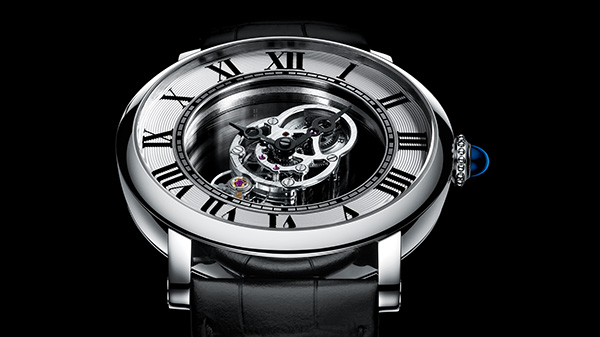
Cartier: Flight of Imagination
By Scott Hickey
Everyone loves a good mystery, and this year Cartier has crafted one for the ages.
For more than a century, the legendary maison has fascinated the public with an irresistible spell that combines the power of machines and magic. The tradition began in 1912 with the first mystery clock, an ingenious invention in which the hands appeared to float as they orbited a clear dial.
In recent years, Cartier revisited the idea of the mystery clock to develop a new generation of mystery watches, including the Mysterious Hour and Mysterious Double Flying Tourbillon, the latter being Geneva Seal certified. Impressive as they are, the Manufacture Cartier in La Chaux-de-Fonds has outdone itself with the Rotonde de Cartier Astromystérieux. The design artfully blends elements from the modern Mysterious collection and the Rotonde de Cartier Astrotourbillon to conjure an original design that most certainly exceeds what Louis Cartier and clockmaker Maurice Couët dreamt was possible when they collaborated on the original mystery clock.
Clandestine Complication
Instead of a floating tourbillon or hands, the Astromystérieux’s entire movement (9462 MC) appears to be suspended inside a halo of Roman numerals. What’s visible — the escapement, balance wheel, gear train and barrel — completes a full rotation every hour and serves as the watch’s minute hand. What you can’t see are the four sapphire crystal discs stacked on top of one another in the center and the additional gearing that surrounds them. This complex system is responsible for a number of vital tasks, everything from rotating the movement and turning the hour hand, to setting the time and winding the mainspring.
Without a doubt, the revolutionary design behind the Astromystérieux represents a remarkable technical achievement. And in most any other watch, it likely would be the main attraction. But here, Cartier uses the engineering as a means to make a bold artistic statement, one whose purpose is to make you forget about the mechanical minutia and instead lose yourself in the mystery.
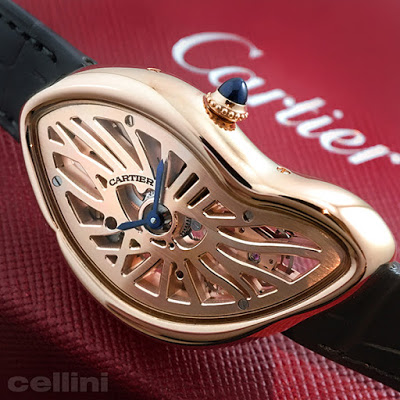
Crash Skeleton
Presented in a 43.5mm palladium case, the Astromystérieux is part of a numbered series limited to just 100 pieces.
Doing More With Less
Even as the number of skeletonized movements grows, Cartier finds ways to rise above the crowd with timeless aesthetics and the exquisite finishing used to decorate its sculptural movements. This year, the maison introduced two timepieces that epitomize its tireless dedication to horological artistry.
The first is rooted in one of Cartier’s most daring designs, the Crash, which originated in 1967. In its modern incarnation, the Crash Skeleton is larger than the original, heightening the visual impact of the asymmetrical case and movement, a shape that articulates the notion of perfection through imperfection.
Carved from the movement bridges, Cartier’s signature Roman numerals are bent, but still beautiful thanks to details like beveled edges and a satin finish that contrasts with the polished case. The clear exhibition back shows off the unusual arrangement of the gearing that makes up the hand-wound movement, which is made exclusively by Cartier. To honor the year of the Crash’s birth, production of this version is limited to 67 pieces.
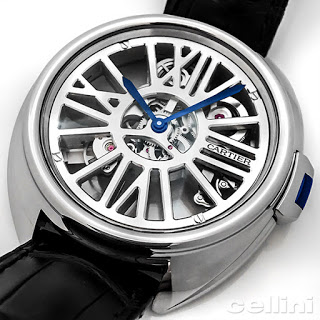
Clé Skeleton
Inspiration for the Clé Skeleton, however, comes from a design introduced just last year. Named after the French word for “key,” the Clé recalls traditional key-wound clocks with details like the clicking sound that’s made when the sapphire-set crown is turned.
The juxtaposition of the case’s flowing lines against the angles of the Roman numerals is outstanding, but so is the watch’s technical pedigree, which includes Cartier’s first automatic-winding skeleton movement. The major challenge for watchmakers was to minimize the winding rotor on the back so that it wouldn’t detract from the airy design, but still power the mainspring efficiently. The result is a success on both counts.
Grace Under Pressure
Dive watches — like those who use them — are a special breed. Unlike most timepieces, all dive watches must include certain features and meet specific performance standards designed to protect the diver.
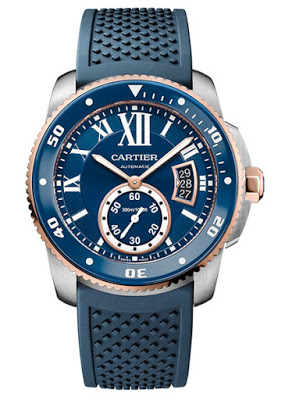
Calibre de Cartier Diver
Cartier approached the creation of the Calibre de Cartier Diver with a determination to not only make something that was authentic, but to do so while maintaining the brand’s signature look and feel. When the first wave of Cartier divers arrived two years ago, it was clear the maison was ready to jump headfirst into the category. From a technical standpoint, the Calibre de Cartier stands on solid ground, checking all the requisite boxes for its ISO 6425 certification: water resistance to 300 meters, unidirectional bezel, luminous display and screw-down crown to name a few.
But the brand didn’t stop there. It equipped the watch with its own automatic movement, the 1904-PSMC, a caliber that takes its name from the year Louis Cartier created the first men’s wristwatch for his friend, the pilot Alberto Santos-Dumont. The movement’s svelte profile allowed the Calibre de Cartier Diver to become the world’s thinnest dive watch, with a case that is just 11mm thick.
This year, Cartier updated the Calibre de Cartier Diver by introducing blue to the collection. The striking azure-colored dial — complete with the brand’s characteristic Roman numerals — matches the ceramic bezel. Like the original Calibre de Cartier Diver, three versions of the 42mm case are available: stainless steel, rose gold or a combination of both. The watch comes on a blue-rubber strap that is offered exclusively in North America.
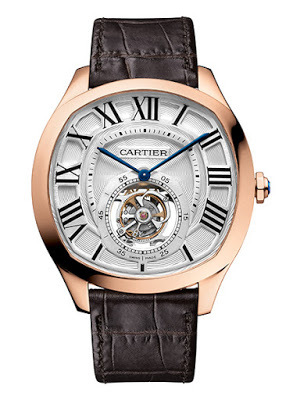
Drive de Cartier Flying Tourbillon
High-Flying Style
The Drive de Cartier collection was one of the most talked about introductions for men this year, earning raves for its refined yet sporty style.
That appealing aesthetic begins with a new case shape that’s similar to a cushion, but with a more streamlined silhouette. Despite its 40mm diameter, the case wears like that of a smaller watch and rests easy on the wrist thanks in part to its trim (11.25mm) profile and contoured lugs. Beneath the shaped crystal, the dial’s elegant proportions and balanced arrangement echo the outline of the case while articulating the cohesive vision behind the design.
The pinnacle of the collection, at least in terms of complication, has to be the Drive de Cartier Flying Tourbillon. The movement at the heart of the watch is Cartier’s tried-and-true 9452 MC, an in-house caliber that epitomizes the incredible strides the brand has made since it introduced the Fine Watchmaking collection in 2008. Since then, the Cartier Manufacture has introduced nearly 50 in-house movements, a remarkable achievement by any measure.
The purpose of the tourbillon is to average gravity’s detrimental effect on timekeeping by rotating the balance and escapement inside a cage. The design featured in the Drive de Cartier, however, goes one step further. Unlike most, this is a flying tourbillon, a variation that has no bridge across the top of the rotating cage. The arrangement provides a clear view of the C-shaped tourbillon cage, which doubles as a small seconds hand as it rotates once per minute.
The tourbillon’s beauty is matched by the multi-level dial, which combines an openworked layer of Roman numerals on top of a white guilloché base, a hallmark of Cartier’s Fine Watchmaking collection. The rose-gold case — with its polished bezel and satin-finished sides — adds an elegant touch.
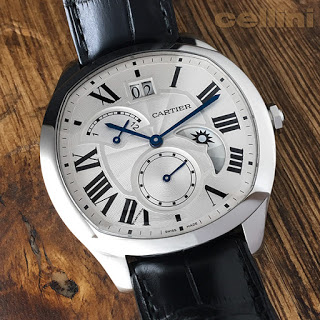
Drive de Cartier Second Time Zone
What Drives You?
In addition to the tourbillon model, there are six other members of the Drive de Cartier family. The first version — offered in stainless steel or rose gold — indicates the time and date, and features a small seconds at the bottom of the silvered flinqué dial. Two additional models provide a nice visual twist by pairing a gray dial with numerals that match the case metal.
All four Drive de Cartier models are equipped with the 1904-PS MC, the maison’s in-house automatic movement. If you’re curious about the PS included in the movement’s designation, it refers to the petite (small) seconds function.
The two remaining pieces in the collection take an unconventional approach to the second time zone complication. Instead of a GMT hand, a window display or a separate dial, the Drive de Cartier Second Time Zone indicates the time in a different zone using a 12-hour retrograde hand in tandem with a day/night indicator.
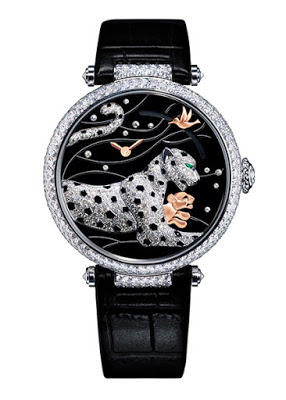
Panthers and Hummingbird
This model retains the date function, but here it’s transformed from a small window at three o’clock into a large date display at the top. All of this functionality is powered by Cartier’s self-winding 1904-FUMC movement — FU for fuseau, or time zone in French. It’s all tucked neatly into a 40mm case that’s offered in either rose gold or stainless steel.
Curious Cats
This year, Cartier put an unprecedented focus on bringing together the two specialties that represent the brand’s twin pillars: fine watchmaking and high-jewelry design. The results of this audacious collaboration are absolutely breathtaking.
Among the highlights are two superlative timepieces for women. First is the Panthers and Hummingbird, which deftly combines jewelry craftsmanship with imaginative watchmaking.
The 42.75mm white-gold case, set with 314 diamonds, forms a circular frame around a golden hummingbird perched atop one of Cartier’s signature panthers, which itself is comprised of 270 diamonds, a pear-shaped emerald eye and black lacquer spots. Pushing the diamond-set crown sets the scene in motion, which begins with a panther cub jumping out from behind its mother to chase the bird that takes flight in an arc across the dial. More than a charming visual spectacle, the length of the bird’s flight indicates how much power remains stored in the hand-wound movement, which is made in-house by Cartier.
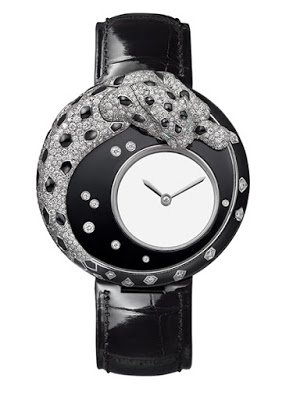
Panthère Mystérieuse
Another exceptional creation born from this collaboration is the Panthère Mystérieuse, a watch that combines two of the maison’s historic traditions — the mystery clock and the panther motif.
Here, the mechanical slight of hand used to tell the time is surrounded by a panther sculpted from white gold and decorated lavishly with white diamonds, black lacquer and emeralds. A sight to behold, the watch is an absolute showstopper thanks to the three-dimensional panther that rises up from the dial as it peers intently at the hands orbiting untethered around the dial.
Infinite Style
Cartier’s ability to conjure instantly recognizable shaped watch cases is rooted firmly in its experience as a jeweler, where mastering the relationship between shape, proportion and volume is paramount. For more than a century, Cartier has put its indelible stamp on watch history with iconic cases like the Tank, Crash and Ballon Bleu.
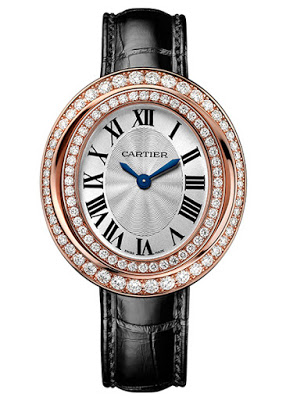
Hypnose
Earlier this year, the maison unveiled a new contender for that legendary list — the Hypnose. The case certainly lives up to its name with a mesmerizing arrangement of graduating ovals that get smaller as they move toward the center of the dial. The case, which is available in rose or white gold, consists of two diamond-set rings, one nested inside the other. They surround the silvered flinqué dial, which includes Roman numerals and an oval section at the center decorated with a sunray finish.
The Hypnose’s rose or white gold case comes in two sizes: small (30 x 26.2mm) and medium (37.8 x 33.3mm). Cartier also makes a special full-pavé model that comes on a diamond-set bracelet and incorporates a black lacquer ring into the case. All of the watches in the Hypnose collection are powered by quartz movements, which allows Cartier to streamline the design by moving the crown from the side to the caseback.
The range of watches that Cartier introduced this year is extraordinary, from true haute horlogerie pieces like the Astromystérieux and Panthers and Hummingbird, to must-have designs for men and women like the Drive de Cartier and Hypnose. What’s doubly impressive is how effortless Cartier makes all of it look.
